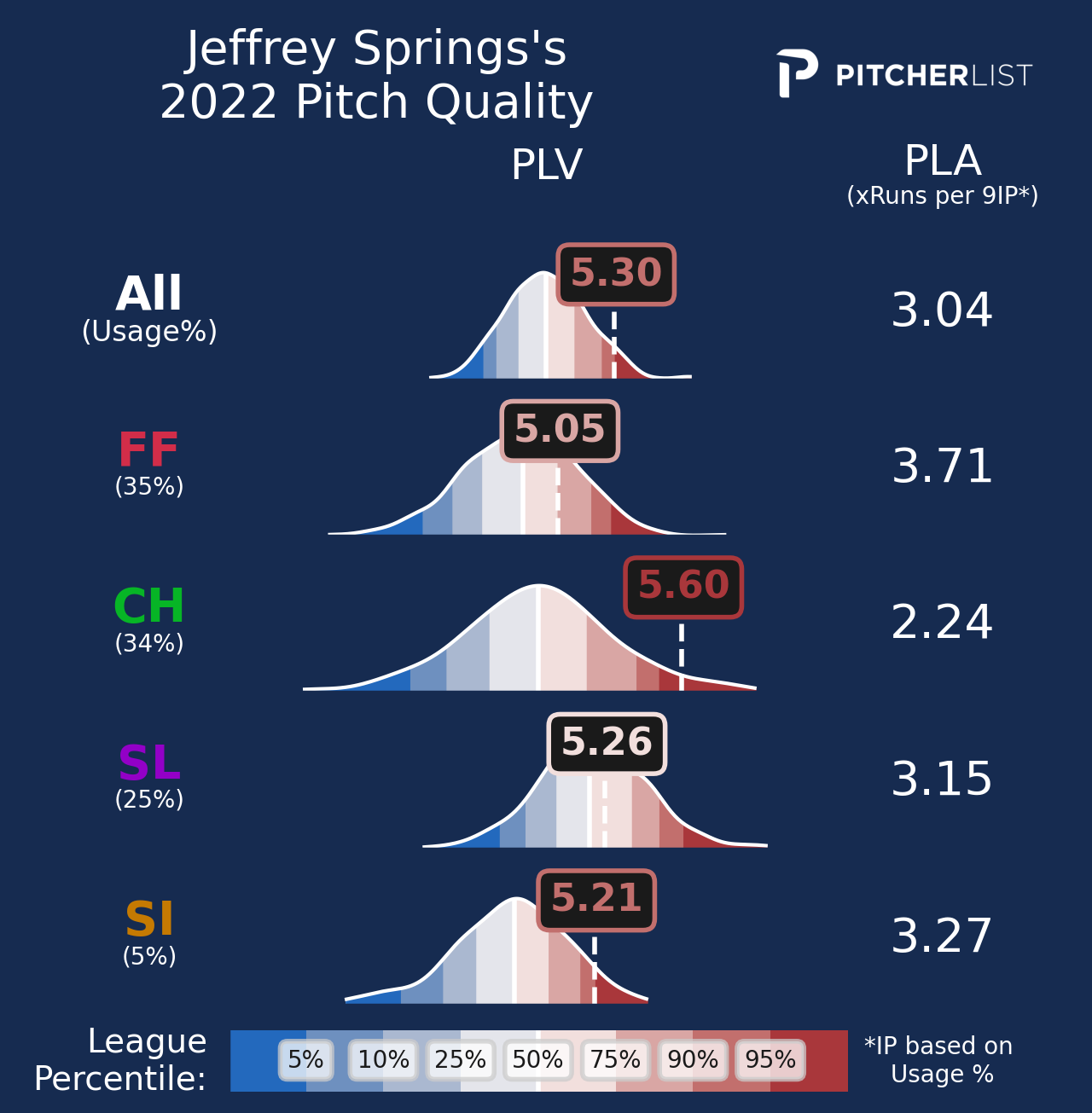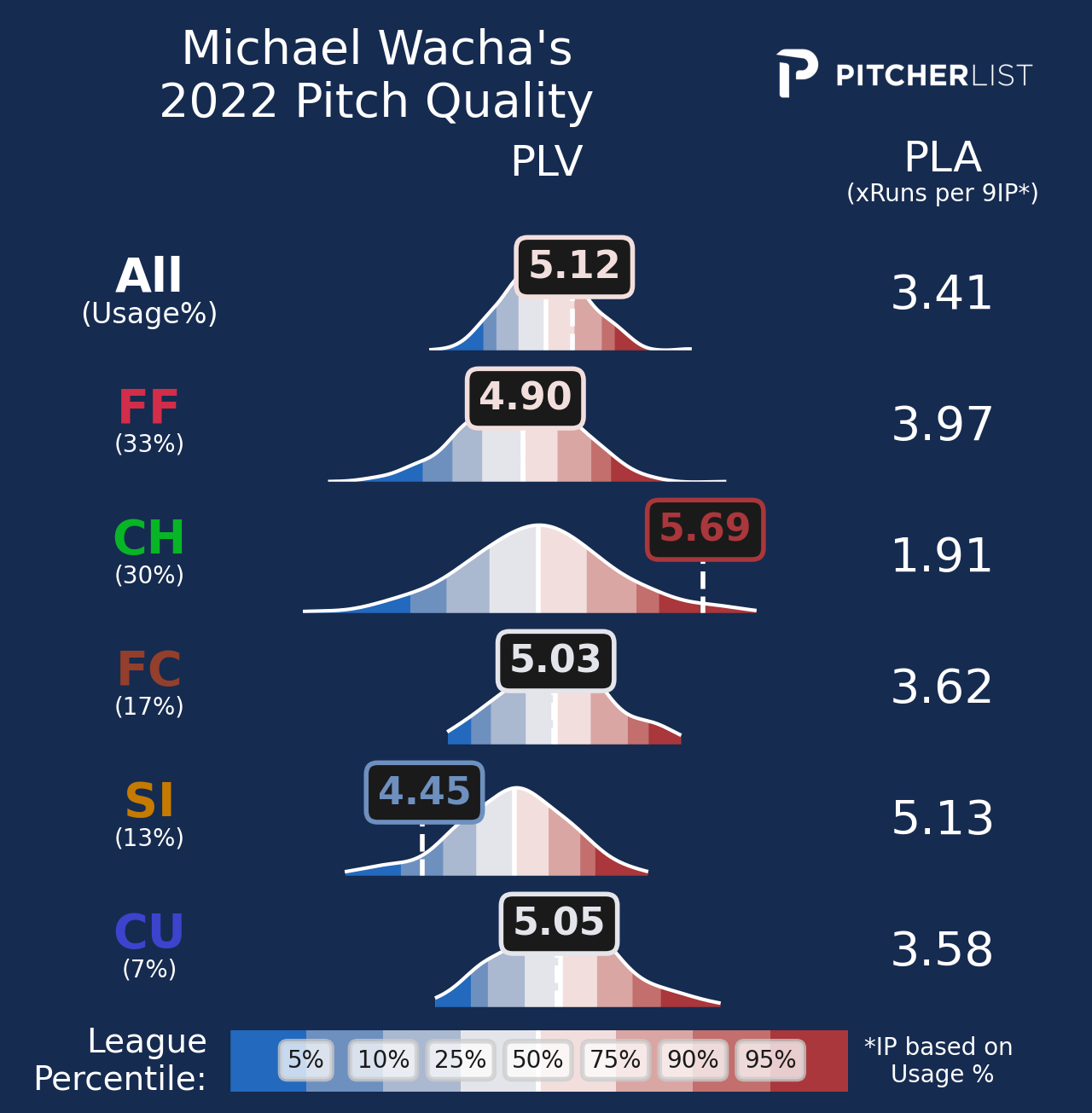Every year for the past few years, I spend a portion of the fantasy baseball preseason taking a look at the best of each pitch type from the year prior. Why? For two reasons: 1. Because pitching is fun and I enjoy writing about fun things, and 2. Sometimes these articles can clue you into pitchers that may be a value for you in fantasy drafts.
I’ve always been a believer in trusting the stuff. If a pitcher is throwing nasty pitches successfully, they’re likely already one of the better pitchers in the league, or they’ve got the potential to be. Now, of course, that comes with the caveat that there are plenty of pitchers who have basically one awesome pitch and a bunch of garbage pitches. That does happen of course.
But in this article, and in a series of articles that’ll be coming after it, I’m going to be taking a look at the five best pitches of each pitch type, and today we’re starting with the five best changeups of 2022.
Now, if you’ve read my pitch review series in the past, you may remember that I used to rank these pitches by pVAL. Up until now, pVAL was an imperfect but very available and useful way to sort of quantify a pitch and say “this is a good pitch” or “this is a bad pitch.”
There are plenty of issues with pVAL though, which is why we here at Pitcher List have developed our own way of numerically quantifying the quality of a pitch — Pitch Level Value, or PLV.
What is PLV? I’m so glad you asked. The wonderful, delightful, and always brilliant Nick Pollack wrote an in-depth primer on exactly what PLV is, so if you want the nitty-gritty details of it, it’s all there. But if you want the short version just for the purposes of this article series, PLV is a numerical way to quantify the pure quality of a pitch, regardless of the events that occur around that pitch (i.e. if a great slider is thrown in an excellent location but the hitter is able to knock a home run off of it, because they’re a great hitter).
Another quick note before we get started: the pitches included in this series were thrown a minimum of 300 times last year. I wanted to include pitches that were thrown pretty frequently (as opposed to the outliers thrown well like 100 times in the whole season) and were dominant, and I felt a minimum of 300 pitches was a good place to start.
So, without any further introduction, let’s take a look at the five best changeups by PLV for 2022.
https://gfycat.com/groundedfittingfowl
This isn’t the first time Jeffrey Springs has been mentioned on a list of some of the best pitches of 2022 — his changeup was also on my list of the 10 most-chased pitches in baseball last year, coming in at number four with a 47.9% chase rate.
Up until last year, Springs had spent his major league career as a reliever. Last year, however, Springs started 25 games and looked fantastic, posting a 2.46 ERA, 3.04 FIP, 3.27 xERA, and a 1.07 WHIP.
That changeup was a big reason why. Alongside that 47.9% chase rate, Springs’ changeup posted a 21.5% swinging-strike rate, 32.8% CSW, a .255 wOBA against, and a .091 ISO against, with a PLV of 5.60, well above the league average of 4.96.
But while Springs’ changeup is fantastic, his whole repertoire comes in at either average or above average from a PLV perspective:

That’s pretty impressive, and it leads me to believe he’s more legit than not. This is a prime example of what I mean when I say I trust a pitcher’s stuff. Springs is going out there, putting up good numbers and surprising people, and the natural first reaction is to say “is this for real, or is this luck?”
PLV will tell you he’s got great stuff, and considering his ADP right now as of this writing is around 174, you may be able to get a pretty darn good pitcher for a decent price.
https://gfycat.com/yellowhealthyarctichare
It’s been a while since Michael Wacha put together a quality season. Last year, Wacha Flacha Flame posted a 3.32 ERA through 127.1 innings, marking the best ERA he’s had since his 2018 season with the Cardinals and the third-best ERA he’s ever posted in his career.
Before last year, Wacha had some not-so-great numbers, posting a 5.05 ERA with the Rays in 2021, a 6.62 ERA in 2020 with the Mets (though just through 34 innings), and a 4.76 ERA in 2019 with the Cardinals.
But last year was very good for Michael Wacha, and that changeup is a big reason why. Last year, the pitch posted a 41.4% chase rate and a 20.5% swinging-strike rate on its way to a 5.69 PLV.
But when you look at the rest of Wacha’s arsenal, that’s where things get a little concerning:

That changeup was far and away his best pitch. In fact, it was basically the only pitch he had that wasn’t around league average or worse.
And even more concerning? Wacha’s 3.32 ERA came with a 4.25 xERA and a 4.15 FIP. Given those numbers, Wacha’s history, his relatively low strikeout numbers, and the fact that he’s now signed with the Padres and a spot in the rotation isn’t guaranteed, he’s someone I’m avoiding in drafts.
But hey, great changeup.
https://gfycat.com/vigorouspeacefulbullmastiff
Devin Williams is one of the most fun pitchers to watch in all of Major League Baseball because the guy has just plain nasty stuff. I mean, take a look at his Pitcher List player page, it’s basically all red.
Williams had the busiest season of his career so far last year, pitching in 65 games, totaling 60.2 innings, logging 26 holds and 15 saves, and posting a 1.93 ERA with a 2.00 FIP and a 1.97 xERA.
And the big reason why? This changeup. It’s always been Williams’ money pitch and it was yet again last year, posting a 42.2% chase rate, 22.2% swinging-strike rate, 35.8% CSW and a .237 wOBA against.
Williams primarily went with a changeup/fastball combo last year, with the changeup being his main putaway pitch. The fastball was no slouch though. While it didn’t draw strikeouts like the changeup, it was excellent at inducing weak contact as opposing hitters had a .187 wOBA against the pitch.
One of my favorite pitches to watch in all of baseball, as long as that changeup does what it does for Williams, he’s going to continue to have success.
2. Tyler Wells
https://gfycat.com/keengreenaustraliankestrel
Tyler Wells spent 2022 as a starter for the first time, after coming up and pitching 44 games out of the bullpen in 2021.
Wells’ season was cut short by a shoulder injury, but ultimately, he pitched to a 4.25 ERA, 4.52 FIP, and a 3.78 xERA over 23 starts and 103.2 innings with an 18% strikeout rate.
Not the best numbers, but without question, there is potential in Tyler Wells as a pitcher. Take a look at his repertoire:

Obviously, the changeup stands out — it posted the second-best PLV among all changeups last year and it worked great as a swing-and-miss pitch, posting a 37.9% chase rate, 18.1% swinging-strike rate, and a 32.6% CSW.
But while his changeup is excellent, the rest of his repertoire is solid too. The slider posted a 35.8% chase rate and a 27.3% CSW alongside a .282 wOBA against, and the four-seamer — while it got knocked around a little bit to the tune of a .366 wOBA against — was pretty decent at inducing some whiffs, with an 11.5% swinging-strike rate.
There’s plenty for Wells to improve on, but while the 4.25 ERA from last year looks concerning, there’s definitely potential here. The biggest issue is going to be finding a spot in the Orioles’ rotation this year, which looks like it may be crowded. Kyle Gibson and Cole Irvin have their spots locked down. That leaves Dean Kremer, Kyle Bradish, Grayson Rodriguez, Austin Voth, and Wells to compete for the last three spots. And I could easily see Wells ending up as the odd man out there.
https://gfycat.com/immaterialdeadlyeyas
I’ve been writing a good bit about Ross Stripling this offseason. He’s been featured in not only the 10 most-chased pitches of 2022 (with this changeup) but also my article on 12 under-the-radar pitchers with money pitches in 2022 (also with this changeup).
If you’ve read those articles, you know the story on Stripling — he was mostly in the bullpen for the Blue Jays in 2020 and 2021 and was pretty bad, posting a 5.84 and 4.80 ERA respectively.
But then last year, Stripling was starting again and posted a 3.01 ERA, 3.11 FIP, and a 3.57 xERA through 134.1 innings thanks in large part to a change in his approach:
Back on the Ross Stripling thing cause why not
A reason I'm really interested in his potential – look at the changes between 2021 and 2022
FB is about the same but started using the CH more (which was really good!) and his SL more, decreasing his CB usage pic.twitter.com/kEzAKsUR41
— Ben Palmer (@benjpalmer) January 31, 2023
This changeup was a big reason why Stripling succeeded last year, posting a 46.7% chase rate, 20.9% swinging-strike rate, and a 41.7% zone rate alongside a .244 wOBA against. It was great in just about any metric you can think of.
Oh yeah, and the 5.79 PLV it had that led the league among all changeups? That PLV was good for the seventh-highest PLV among all pitches in baseball. That’s how good Stripling’s changeup was, and it’s one of the reasons I’m very interested in him as a sleeper in drafts this year.
Graphic adapted by: Chris Corr (@Chris_Studios on Twitter)

